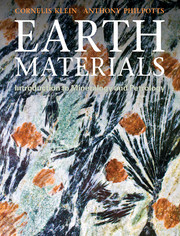Book contents
- Frontmatter
- Contents
- Preface
- Acknowledgments
- Chapter 1 Introduction
- Chapter 2 Materials of the solid Earth
- Chapter 3 How are minerals identified?
- Chapter 4 Fundamentals of crystal structures
- Chapter 5 Introduction to crystallography
- Chapter 6 Minerals and rocks observed under the polarizing optical microscope
- Chapter 7 Igneous rock-forming minerals
- Chapter 8 How do igneous rocks form?
- Chapter 9 Igneous rocks
- Chapter 10 Sedimentary rock-forming minerals and materials
- Chapter 11 Formation, transport, and lithification of sediment
- Chapter 12 Sedimentary rock classification, occurrence, and plate tectonic significance
- Chapter 13 Metamorphic rock-forming minerals
- Chapter 14 Metamorphic rocks
- Chapter 15 Some economic minerals, mainly from veins and pegmatites
- Chapter 16 Some selected Earth materials resources
- Chapter 17 Earth materials and human health
- Glossary
- Minerals and varieties
- Common igneous, sedimentary, and metamorphic rocks
- Index
Chapter 2 - Materials of the solid Earth
- Frontmatter
- Contents
- Preface
- Acknowledgments
- Chapter 1 Introduction
- Chapter 2 Materials of the solid Earth
- Chapter 3 How are minerals identified?
- Chapter 4 Fundamentals of crystal structures
- Chapter 5 Introduction to crystallography
- Chapter 6 Minerals and rocks observed under the polarizing optical microscope
- Chapter 7 Igneous rock-forming minerals
- Chapter 8 How do igneous rocks form?
- Chapter 9 Igneous rocks
- Chapter 10 Sedimentary rock-forming minerals and materials
- Chapter 11 Formation, transport, and lithification of sediment
- Chapter 12 Sedimentary rock classification, occurrence, and plate tectonic significance
- Chapter 13 Metamorphic rock-forming minerals
- Chapter 14 Metamorphic rocks
- Chapter 15 Some economic minerals, mainly from veins and pegmatites
- Chapter 16 Some selected Earth materials resources
- Chapter 17 Earth materials and human health
- Glossary
- Minerals and varieties
- Common igneous, sedimentary, and metamorphic rocks
- Index
Summary
This text has the title Earth Materials. An inclusive definition of Earth materials encompasses the following: minerals and rocks, which are the solid parts; soils, the unconsolidated materials above bedrock; fossil fuels, which include all the hydrocarbons used for fuel and energy – petroleum, natural gas, and coal; the various forms of H2O, in salt water and freshwater, in glaciers and ice caps; and the atmosphere, the mixture of gases that surrounds the Earth.
This book is an introduction to the solid materials that compose the Earth, but short discussions of soils (Chapter 10), coal (Chapter 12), and H2O and fossil fuels (Chapter 16) are included.
Solid materials are found abundantly underfoot on hiking trails in mountainous regions, but they are also present on beaches all around the globe. The solid materials in mountain chains, most commonly seen as outcrops in highway cuts, are rocks. Some common rock types are granite, basalt, limestone, and sandstone. The loose, solid materials on beaches consist mostly of the mineral quartz (with some minor components such as feldspar and mica grains mixed in) or calcite. Almost all beach sands are quartz rich, but some in the Caribbean consist mainly of granular calcite.
This book deals extensively with various aspects of minerals and rocks, and our main objective is to understand their origin and identification. Therefore, we are concerned with the questions of why and how chemical matter (elements and ions) is organized into particular minerals and rocks, and how minerals and rocks react to physical changes (e.g., in temperature and/or pressure) in the Earth’s interior and to chemical changes in those exposed to the atmosphere. Parts of the text are also devoted to mineral and rock descriptions, because they are essential as basic knowledge for further discussion and for their identification in the laboratory or in the field.
- Type
- Chapter
- Information
- Earth MaterialsIntroduction to Mineralogy and Petrology, pp. 14 - 37Publisher: Cambridge University PressPrint publication year: 2012



